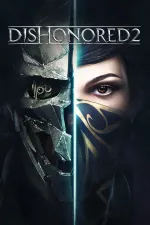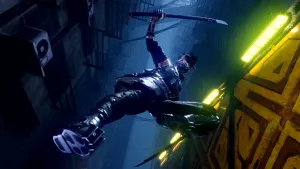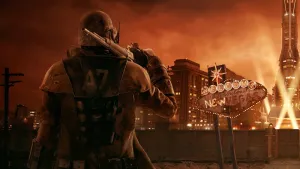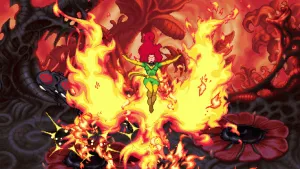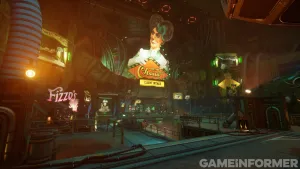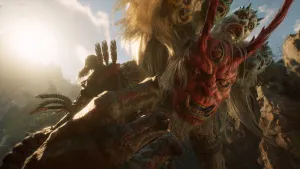Dishonored 2
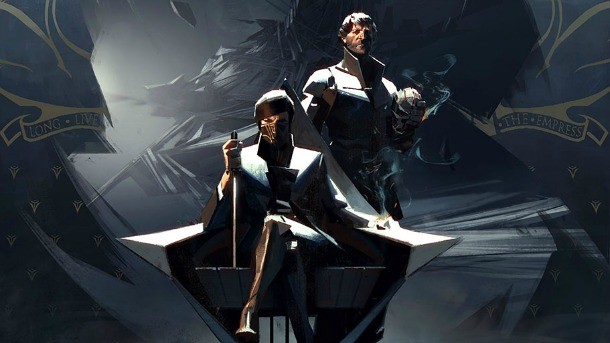
Editor's Note: The following article appears in Game Informer Australia issue #83 and is written by David Milner. You can follow him on Twitter here.
A lot can happen in 15 years. After supernatural assassin Corvo Attano vanquished the treasonous Lord Regent, restoring Emily Kaldwin to her murdered mother’s throne, Dunwall saw a new era of peace and prosperity.
Young Emily grew into her royal responsibilities. Her reign brought about the end of the deadly rat plague. The city’s whale oil industry churned on, vat after volatile vat, carcass after harpooned carcass. The realm’s poorest denizens no longer felt crushed beneath the boots of a paranoid, illegitimate regime. Times were good.
But nothing lasts forever, and being usurped happens to run in the family...
Making Dunwall Great Again
At a recent media event in Sydney, I had the chance to go hands-on with Dishonored 2, a sequel that feels more assured than its predecessor. Arkane has doubled down on what worked last time – the rich lore, the creative assassination scenarios, the fun supernatural abilities – and addressed many of the issues I had with the first game: primarily, that playing non-lethally wasn’t as enjoyable as the more murderous approach.
At the risk of history repeating, Dishonored 2 begins as Emily Kaldwin is violently overthrown by a mysterious foe known only as an “otherworldly usurper.” Corvo and Emily – both now marked by The Outsider, gifting them unique abilities in the ways of the stabby arts – head for the coastal city of Karnaca, which holds the key to restoring Emily to her throne.
My demo drops me into the game’s fourth mission, The Clockwork Mansion. In the three hours I have, I manage to complete it three times, once with Corvo and twice with Emily, utilizing different approaches and powers, prodding and bending Arkane’s sandbox to see what it will let me get away with. Although I’ve only scratched the surface of possible ability combinations, the game happily went along with every dastardly kill I tried to dream up using its deadly tools.
The Clockwork Mansion is the home of Kirin Jindosh, the creator of the Clockwork Soldiers that patrol Karnaca, enforcing the rule of the new oppressive regime. Nestled atop a pale rocky mountain, the structure towers above the seaside town below.
My visit to the compound has two objectives: rescue Anton Sokolov – the eccentric Rasputin-esque inventor from the first game who has again found himself imprisoned – and eliminate Jindosh as a threat. Lethally or otherwise.
Naturally, I begin as the new playable character Emily Kaldwin. Upon completing the trolley-car ascent up the mountain and arriving at the mansion’s entrance, Emily mutters that the building “has a strange beauty.” The same can be said for the game itself.
I appreciate that the first Dishonored carved out a unique art style – but it would be hard to describe it as beautiful. The exaggerated character models often came across as low-res rather than painterly; the washed-out color palette felt stylized, but also a little on the drab side.
Without abandoning its signature style, Dishonored 2 is a far prettier game: people still have caricatured features, but they’re now coated in the textures and the minute details you would expect of a triple-A release in 2016. Lighting casts impressive shadows, and animations are fluid. If the last game saw the invention of a visual style, this game is its necessary refinement.

“Maybe I can find a way to end this without killing Kirin Jindosh,” Emily ponders as she enters his mansion. Thankfully, the silent-protagonist trope of the original game has been replaced with fully voiced parts for both Emily and Corvo, adding yet another subtle reason to play the game multiple times.
Although the footprint of the multi-story mansion isn’t huge, there’s a lot to get my head around. Jindosh has crafted his home with the same madness that led to his Clockwork Soldiers. Walls rotate at the flick of a switch; staircases unfold out of nowhere; harmless pianos are replaced with deadly concealed Arc Pylons. Think of The Riddler’s traps for Batman, crossed with the shifting layout of Hogwarts, then add an industrial, clockwork nerve centre and an opulent, gaudy motif and you’ve got the picture.
As each transformation is triggered, new routes become available to the player. Sometimes it’s even necessary to slip between the walls while they’re reconfiguring, giving you access to the mechanical heart of the mansion, allowing you to disable a pesky Wall of Light or creep around an encounter. But be careful: on numerous occasions I found myself squished between the moving masonry with a poorly timed Blink or leap.
The creative level design of the Clockwork Mansion is hands-down the highlight of my time with the game. In its short life, Arkane already has a history of crafting memorable stages – Lady Boyle’s Last Party from the first Dishonored stands up as an all-time classic video game sandbox – and that deft touch is on display here.
Although the Clockwork Mansion isn’t as sprawling and open to multiple routes as some of the largest stages from the first game, this can likely be attributed to the fact that it’s an early-game mission and the necessary handholding hasn’t abated just yet. If this inspired level design extends to the rest of the game, Dishonored 2 is going to provide us with some fantastic scenarios in which to deal out death from the shadows.

The Face Of Madness
Upon flicking a switch in the entrance, the dead end before me transforms into a grand foyer with two flights of stairs. Unfortunately, Jindosh knows I’m coming. “Welcome, visitor,” his voice sneers across a loudspeaker. “My home is always open. It’s one of my great curiosities, seeing how the common mind navigates these shifting rooms.”
A Clockwork Soldier rises before me from a panel in the floor. Using Emily’s Shadow Walk ability, which transforms her into a dark crawling mist, making her harder to detect, I’m able to sneak behind it and trigger an instant kill with the right trigger. Emily jams her knife into the machine’s knee before moving her blade up to its mechanical spine, severing it in a shower of sparks and metal.
As far as I can tell, there’s no nonlethal way to get past Clockwork Soldiers other than to avoid them entirely. As with the original game, sneaking behind a human enemy offers you two prompts: RT/R2 to kill and RB/R1 to render unconscious. Given that this doesn’t happen with the Clockwork Soldiers, it’s likely that destroying them doesn’t affect your chaos rating negatively – a nice touch, allowing pacifist players the chance to deal out some satisfying destruction without starting down the darker path.
“Most unexpected and truly impressive. Not many people would still be standing after that,” Jindosh asserts, anger sneaking into his tone. Before long we’re face to face with each other, an unbreakable glass door the only thing keeping Jindosh safe.
He sizes me up, judging my clothes and appearance, correctly identifying me as the deposed Empress (during my Corvo playthrough, Jindosh’s lines are almost identical, only replacing the name right at the end). Jindosh queries whether I’m there to kill him or to rescue Sokolov – it apparently hasn’t occurred to him that I intend to do both.
“Either way... if you fall, I’ll have your body carried to my lab for dissection and study,” he says, before walking away and setting more Clockwork Soldiers after me.

Falling Like Dominoes
After dispatching the Clockwork Soldiers, deflecting their blows with my blade and countering while they’re off balance, I press deeper into the mansion. It’s time to put Emily’s new abilities to the test.
Far Leap is Emily’s equivalent of Corvo’s signature Blink manoeuvre, transporting her to otherwise unreachable places. Unlike Blink, Emily doesn’t disappear and reappear elsewhere – she still exists in the world while she’s warping, she just transports through it at a rapid pace. Interestingly, Far Leap appears to be governed to a degree by your momentum. I found that running and leaping off the top of a flight of stairs and then triggering Far Leap mid-jump allowed me to warp much farther than when I was stationary.
Far Leap also has a secondary function: if you aim at an enemy instead of empty space, it yanks them towards you, back along the trajectory that you would have travelled if they weren’t there. It’s similar in outcome to Scorpion’s spear in Mortal Kombat, pulling a foe towards you, leaving them staggered and primed for a blade to the neck.
This Far Leap function can be combined with Emily’s Domino ability for hilarious (and useful) results. Domino links the fates of multiple enemies together. When chained together with Domino, if one foe is rendered unconscious, it’s lights out for the other guy as well. At its starting level, Domino can only chain two people together, but it can be upgraded to link up to four people.
I wondered if this would create balancing problems, making scenarios too easy, but enemies need to be fairly close to each other in order to be linked. This means that through the careful placement of patrol routes, Arkane is able to maintain a degree of challenge while still empowering players.
Entering a corridor deep into the mansion, I spy a pair of guards chatting (no mention of gathering for whisky and cigars, sadly). Linking them together with Domino, I’m now able to dispatch them both at once.
During my first playthrough I fire a sleeping dart at one, knocking them both out, which could be a handy tactic in low-ammo situations. My second run is more creative: I yank one of the Dominoed guards into the air using Far Leap. With their fates entwined, both of them hurtle towards me at the same time. I stab the first guard in the neck as he reaches me, killing both before either hit the ground. I try not to laugh out loud at media demos, but sometimes it can’t be helped.
Emily has another ability called Doppelganger, which summons an exact copy of her for distraction purposes. This wasn’t unlocked in my demo, but I’m told that Doppelganger can be combined with Domino for crazy scenarios: create a copy, link it to your enemies, and then stab or choke your double, killing all the guards without them seeing you.
With all these new abilities, I enjoyed my Emily playthrough more than my Corvo one. Come launch, I’ll definitely be playing through the game with her on my first run.
Jindosh Meets His Fate
After rescuing Sokolov from a cell deep within the mansion and seeing him to the safety of my trolley-car outside, I head to Jindosh’s laboratory for the final confrontation. A pair of Clockwork Soldiers assault me. This duo is more formidable than the earlier units, each with four bladed-arms instead of two. I pull out the pistol and target the small whale oil vats on each arm, causing them to explode. Jindosh himself has been watching from a balcony above. Using Far Leap to reach it, I finally confront the crazed creator.
At this point the player has two options. Killing Jindosh is the easiest way to complete the mission. He goes down in one blow, and a hasty retreat out of the mansion is simple enough. The other choice is far more sinister. You can lobotomize Jindosh using an electric chair – one of his own creations, no less. This requires you to complete an environmental puzzle in order to power up the device with enough electrical current, place his unconscious body in the chair, and then flick the switch and watch him convulse.
The shock treatment takes an agonizingly long time, during which you appear to be given the option of backing out. Holding my nerve, I stand still and watch as Jindosh’s formidable intellect is zapped out of him, leaving behind a harmless, babbling husk.
The fact that the nonlethal ending to this level is arguably more morally problematic than a quick assassination has me intrigued. If Arkane can dream up more murky scenarios that straddle the grey areas between right, wrong and simply getting the job done, there will be an awful lot to talk about upon Dishonored 2’s releases next month.
It’s rare that I leave a demo so free of lingering doubts. There’s a level of craft on display here that just oozes dedication and care. With its inspired level design, fun new powers and characters, refined art style, and improved nonlethal options, Dishonored 2 has gone right to the top of my most-wanted list.

Get the Game Informer Print Edition!
Explore your favorite games in premium print format, delivered to your door.
- 10 issues per year
- Only $4.80 per issue
- Full digital magazine archive access
- Since 1991

